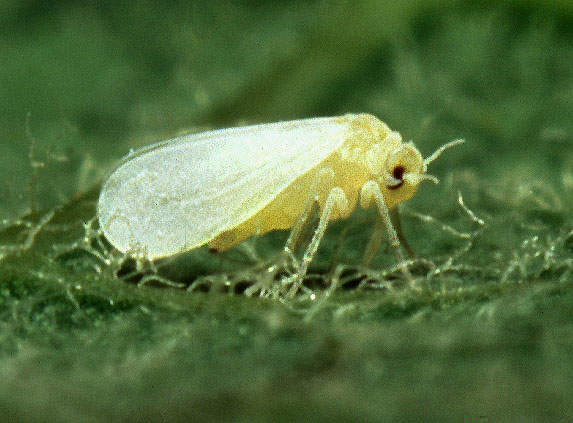Most orchid species are susceptible to whiteflies. These insects are attracted to the softer parts of the plants, where they can easily suck the sap. These persistent pests have, unfortunately developed resistance to chemical control methods (i.e. insecticides), so it is better to prevent infection in the first place. Though it is easier said than done and there is a general belief that some plants are more susceptible to whiteflies. Fortunately, I have not come across any orchids that can be included in this category. However, it always best to keep your eyes open. So, how do we know which plant is more prone to whiteflies? Easy, it is any plant that gets frequently infected and has most of the whiteflies on it.
If there is any such plant in your garden, then remove it to an isolated place. Keep it there till all the pests are dead or are removed. Now coming to eradicattion or at best controlling the spread of this pest? Though numerous options are available to control or kill these pests (you can find these by searching online). Well, I tried most of these methods; at first, I tried killing them, but failed. Then, I tried controlling these sapsuckers, but these kept coming back.
As I have mentioned earlier, whiteflies have and can develop resistance to the available chemical control methods. What suited me most was the physical eradication of the pests. Though, it requires a lot of patience and is applicable only when the infection is on one or two plants. So, the sooner you get to it the better it is.
The method of control (the one that I found effective till now!) is to physically scrape off the eggs and nymphs. The only thing that you require is a pair of gloves (though, frankly I did not use these) and running water.
Armed with this, wet your gloves or hands if you too prefer not wear gloves. Check the undersides of every leaf, especially the younger ones (hoping it is not a very leafy plant). You will find the eggs and nymphs sticking there. Gently scrape these off with your wet fingers and wash it off in running water. Repeat this with every leaf (I said you need patience). After you have cleaned the underside of each leaf, you can spray the plant with a relatively strong jet of water (but not that strong that the plant gets injured!). Before spraying with water, place the plant in such a way that runaway water is drained into the sewage system rather than remaining stagnant around the plant. The residual eggs and nymphs will be removed by spraying. Repeat the excercise after three to four days, till you find the flies are no more laying eggs. Or till the weather changes.
This has worked for me and there are no whiteflies for past one month (fingers crossed). Best of luck to the other ‘fellow whitefly fighters’.

Orchids And The persistent Whitefly
Ailments Cultureby Anu Dharmani
Originally published in BellaOnline
Posted by Sys Admin over 7 years ago.Article Blog Article Index
Share on Social Media:
New Topics
- David George asked question Odom's Fascination - an unusual orchid in category General Discussion
- Carol Holdren asked question Grow Tent in the Garage in category General Discussion
- David George asked question rlc Caotan Beauty found at Home Depot in category Cattleya Alliance
- Kristin Dorris asked question Odontocidium Orchid fungus? in category General Discussion
- Maria Fernandez asked question Wild. Lisa Devos in category Dendrobiums
New Comments
- Carol Holdren commented on topic "rlc Caotan Beauty found at Home Depot " by David George
- Carol Holdren commented on topic "Odom's Fascination - an unusual orchid" by David George
- Dr. Florian Wolf commented on topic "Wild. Lisa Devos" by Maria Fernandez
- Michael Valcarcel commented on member plant Rlc. Chief Takanaka by Walceli Muniz Valverde
- Michael Valcarcel commented on member plant Rlc. Montana Spirit by Michael Valcarcel
- Michael Valcarcel commented on member plant Ctt. Blazing Sun by Michael Valcarcel
- Michael Valcarcel commented on member plant Bc. Spotted Clown by Michael Valcarcel
- Maria Skrypnyk commented on member plant Yamadara Redland Sunset by Maria Skrypnyk
- André Pessina commented on topic "Odontocidium Orchid fungus?" by Kristin Dorris
- Linda Hartman commented on topic "Image of a plant please" by Leshya Perkins
- Paul Reavis commented on orchid Milt. Kismet
- Christiaan Viljoen commented on member plant Psh. fragrans by Christiaan Viljoen
- Christiaan Viljoen commented on member plant Z. maculatum by Christiaan Viljoen
- Christiaan Viljoen commented on member plant C. Gaskell-Pumila 'Azure Star' by Christiaan Viljoen
- Robert H. Findlay commented on member plant Rlc. Joy Sokabe var. Volcano Queen by Sally K
- James Lunsford commented on member plant Lc. Sagarik Wax 'African Beauty AMO/AOS x Blc. Cherry Suisse'Kauai' HCC/AOS var. Cattlyea 'Hybrid ' by James Lunsford
- John Varigos commented on orchid Bulb. schwarzii
- Linda Hartman commented on topic "Issue with Blc. Ben O'Neil "Jubilee" by Glenda Ratliff
- Henry Shaw commented on member plant Ons. Catatante 'Los Roble' by Henry Shaw
- Mary Lane commented on member plant Den. Tianmu Canary by Terre Moore